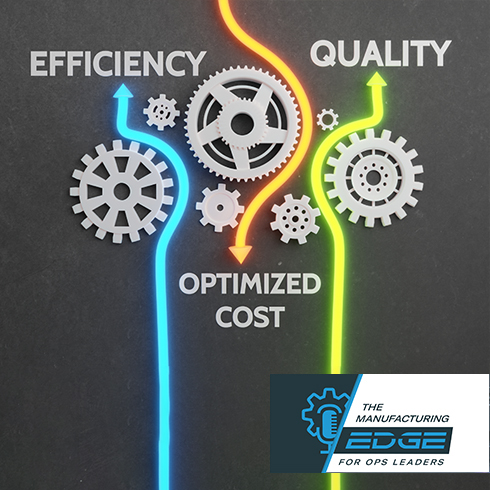Dig deeper to unlock, amplify, and accelerate your value creation opportunity.
If the global pandemic sidelined or sidetracked your business over the past six months, you’re not alone. Despite these realities, private equity firms expect to exit on time with the value they were anticipating pre-COVID. The best way for your portfolio company to meet these expectations is to quickly identify and execute value creation projects that will deliver the highest impact in the shortest possible timeframe.
4 Ways to Accelerate Value Creation
1. Reprioritize Projects Using Timeframe as a Metric.
An impact/difficulty matrix is one of the simplest and most effective tools for quickly selecting value creation priorities. It plots various operational excellence improvements, business process improvements, and improvement opportunities using a simple chart with expected EBITDA impact on one axis and project difficulty level on the other. The purpose is to quickly and clearly create line of sight into where the best rate of return lies and to help you carefully consider the effort required for a particular project’s success. Projects that fall into the upper left-hand quadrant, where the impact is high and the relative effort is low, are obviously the best bets; those that fall further to the right-hand side may not be as feasible.
You can plot this chart using your exit timeline for the X axis, where the numbers represent months to implement. This will show what can realistically be achieved in the timeframe you have available. As you place value creation opportunities on the matrix, be sure to consider how any changes in your demand, supply, and internal capabilities have altered the expected impact, timeframe, and difficulty level of each potential project. Indeed, projects that may have been classified as high-impact but difficult to execute six months ago may fall into an entirely different quadrant today. The key is to ensure that the matrix is as realistic as possible given current market conditions.

2. Make High-Impact/Highly-Challenging Projects More Doable.
Ideally, your impact/timeline matrix will reveal enough opportunity to generate the return your private equity partners are expecting in the remaining time you have until exit. When this isn’t the case, or when there are extremely high impact opportunities that fall outside of the timeline window or that require more effort or resources than you can feasibly invest, it’s worthwhile to explore ways to expedite those opportunities and/or to reduce the difficulty level or implementation hurdles while still maintaining as much of the impact value as possible.
This often starts by breaking down a project into more digestible chunks of work. Getting granular about the actual work that needs to be done can show you if portions of a project can be accomplished. It also sheds light on the specific problems or issues that make a project difficult. When you better understand the problem, you can create a collaborative workplan for addressing it, which can help move a project from the righthand side of the matrix to left.
3. Reduce Costs or Functionally Improve Product Manufacturing Processes.
VA/VE—value added/value engineering—projects are improvements that go beyond traditional operational excellence or purchasing strategies to fundamentally change the way a product is designed or to alter the components and materials used.
Considering that for a typical product, 50 to 70 percent of costs are attributed to materials, there is generally a lot of room for improvement. However, opportunities are often overlooked because they feel complicated and expensive. But many are far simpler than you might think. We recently helped a PE-owned business explore 130 potential value creation opportunities. Almost half that were defined as doable for the business fell into the VA/VE category, and these included several quick wins, like reducing the screw count for attaching two components and removing the plastic bags from a component. All told, the “doable” VA/VE projects accounted for well more than half of the total savings opportunity for the business.
The trick to finding VA/VE projects is to keep an open mind about types of design, material, or process changes are possible within your timeframe and using resources you have available. Avenues to explore include:
- Conducting a part count assessment to identify parts that can be consolidated or eliminated.
- Looking for processes outside your core competencies that can be economically outsourced, freeing up internal capacity that can be put to better use.
- Doing a margin analysis to hone in on products that could be costing you money.
- Considering how to extend VA/VE savings for a specific product across the entire product portfolio.
4. Accelerate Project Execution.
Once you’ve selected projects, it’s time to execute. Any “just-do-it” opportunities—those with the lowest difficulty level or quickest time horizons—should be assigned and implemented as quickly as possible. Even if the return seems nominal for each project, the cumulative effect can add up quickly, all for very little effort.
For those projects that require a more concerted effort, here’s how to accelerate execution:
- Execute more projects in parallel to make up for any lost time during the pandemic.
- Work at the point of impact and engage the experience and input of your front-lines operations people.
- Put the framework of the solution in place quickly and avoid getting delayed by the minor nuances or details.
- Track progress and make it visible to everyone.
- Leverage the synergies created by engaged people, proven processes, and the right supporting technologies.
Get started today.
If there’s ever been a clear case for making speed a priority, it’s now. Your business has no doubt lost ground to the pandemic. However, it is still entirely possible to achieve your private equity owner’s goals. By quickly reassessing opportunities, being open to those that may require fundamental (but viable) changes to product designs or materials, and using proven strategies to fast track implementation, you can help your business realize its full value potential faster.









